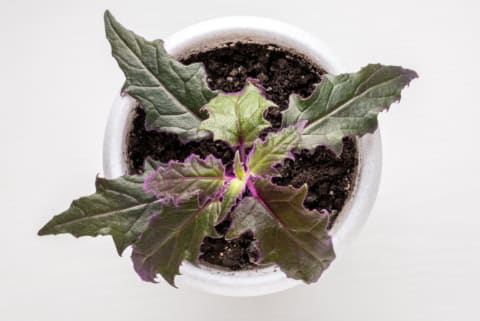Since it thrives in tropical regions, it’s no surprise that this is a plant that appreciates sun and moisture. Its soft purple hairs make it a bit more finicky about light and water than other tropical plants, but it’s still a relatively low-maintenance plant. The purple passion plant is a quick grower. Once they get to one to two feet in height, some varieties begin to trail, making them a good pick for a hanging planter. Unfortunately, this fast growth comes at a cost: This plant has a relatively short life span (two to three years), and once it’s ready to go, it blooms very pungent orange-red flowers as a last hurrah. She cautions against sticking them on the windowsill, as too much sunlight can burn their foliage. Signs your plant is getting too much sun include crispy, curling leaves with brown edges. The tricky thing about this plant is that it isn’t happy in conditions that are too dark either. Its purple leaf detail becomes brighter in the sun, so you’ll want to make sure it’s getting a fair amount of light every day—it just shouldn’t be direct. Sabine H. Schoenberg, the CEO and co-founder of Smart Healthy Green Living, says that it can thrive sitting in the direct morning sun, which tends to be a bit softer than direct afternoon sun, which will burn it. If you are forced to put your purple passion plant near a window that gets lots of sun later in the day, drawing a sheer curtain can help create ideal conditions for this choosy plant. Wilkniss says you’ll likely find that you end up needing to water yours about once a week during spring and summer. “Use a watering can with spout or measuring cup to pour the water directly on the soil,” she advises. You’ll want to avoid getting water on the plant’s fuzzy leaves, as Schoenberg says this can cause them to rot and attract pests. If your plant has sad, droopy leaves, it’s probably thirsty. If it has a sour, rotting smell or yellow and black leaves, it may have been overwatered and be developing root rot (which you should handle ASAP). In addition to the weekly watering, your plant will also enjoy a bit of humidity. Place it in a warm, somewhat humid room that mimics the tropical conditions it thrives in. Avoid misting those fuzzy leaves directly, and place the plant near a humidifier instead. Once your plant really gets growing, it might become too big for its current pot. Keep an eye out for visible roots or an influx of yellow leaves, as these are signs that your plant has outgrown its home and it’s time to repot it. (We’ve got a guide for that.) Feel free to propagate your plant when it’s starting to look leggy, with long stems that overpower the leaves, or when it sprouts red-orange flowers. This is a sign that it is preparing to die back, but clipping a few healthy leaves can give it new life again. Emma received her B.A. in Environmental Science & Policy with a specialty in environmental communications from Duke University. In addition to penning over 1,000 mbg articles on topics from the water crisis in California to the rise of urban beekeeping, her work has appeared on Grist, Bloomberg News, Bustle, and Forbes. She’s spoken about the intersection of self-care and sustainability on podcasts and live events alongside environmental thought leaders like Marci Zaroff, Gay Browne, and Summer Rayne Oakes.




